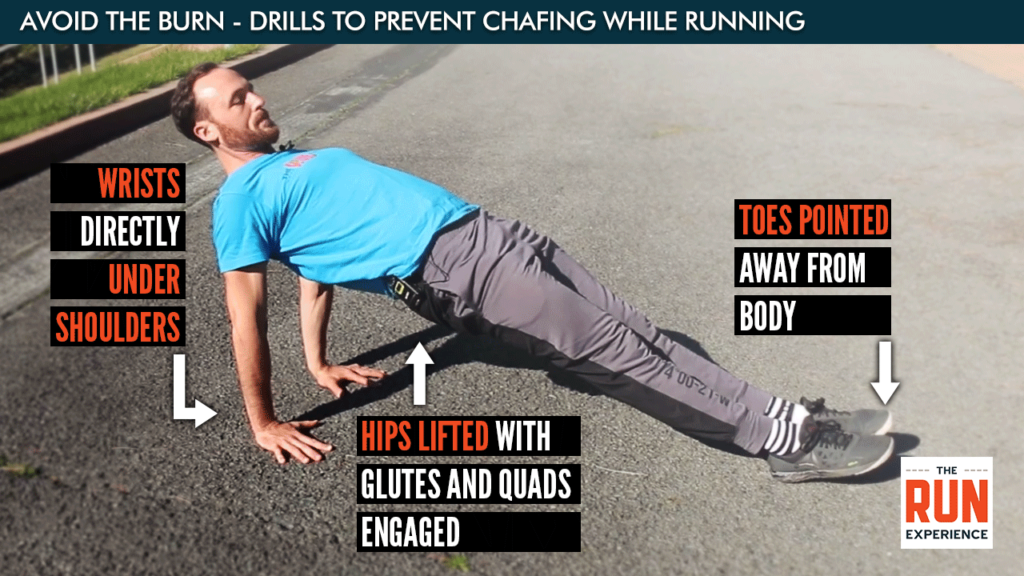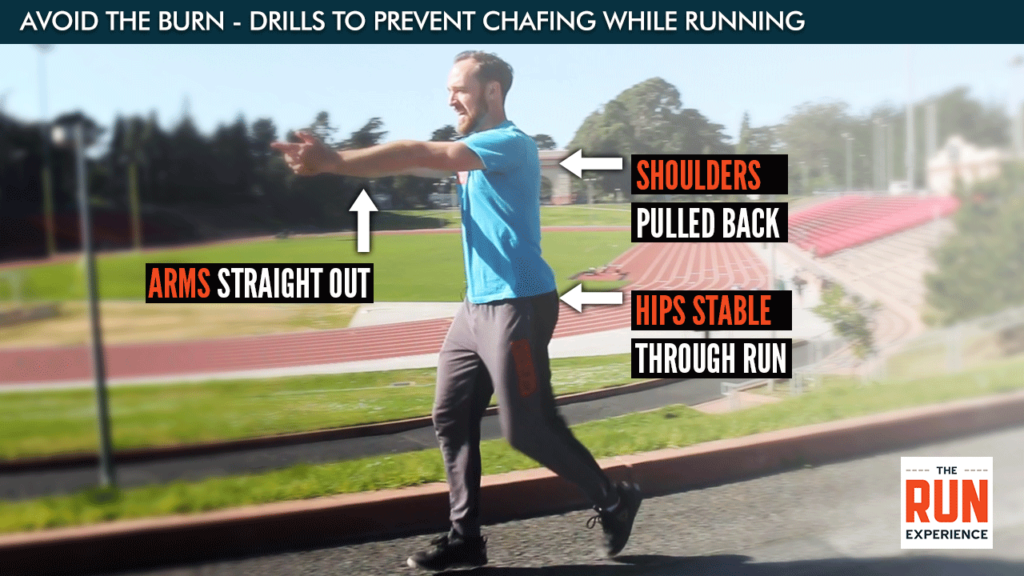How to Prevent Chafing While Running (Avoid Runner's Rash)
Runner's rash got you down? More lube isn't always the answer. Learn how to prevent chafing while running with our tips and running drills.

Chafing is no fun for anybody. Yet, so many of us runners (myself included) are intimately familiar with that burning sting of raw skin as you get in the shower post-run. Just wait till you get some soap on it—runner’s rash is no joke.
Ouch!
This runner’s rash isn’t something you have to deal with, though. Chafing from running is preventable—but the answer isn’t always more lube and stretchy pants.
Instead of grimacing your way through another sufferfest, learn how to prevent chafing while running with 2 of our favorite drills. These drills will prevent thigh chafing and keep the runner’s rash at bay.
What Causes Chafing While Running?
You might think the easy way to prevent thigh chafing while running is to slather on some lube. While that step has its place (more on that later), there are some mechanical changes you can make to your running form that can help avoid the rub.
Friction is the root cause of runner’s rash. Whether it’s skin-on-skin or skin-on-clothing, the repeated friction between the two surfaces is what causes chafing. Runners commonly deal with chafing between their thighs or between their arm and torso (more or less the armpit area).
These aren’t the only two spots that can chafe. But it’s a great starting point to discuss how a check-in on your form can reduce the likelihood of it happening.
What Is Runner's Rash?
Runner's rash, commonly referred to as chafing, is an uncomfortable and often painful skin irritation that occurs due to friction during running or other physical activities. This friction causes the upper layer of the skin to wear away, leading to redness, irritation, and sometimes even bleeding.
The most common areas affected include:
- Thighs: The inner thighs rubbing together or against clothing can quickly become raw during long or intense runs.
- Armpits: Skin in the armpits may rub against skin or the fabric of a shirt or sports bra.
- Nipples: For many runners, especially men, the constant rubbing of a shirt can cause nipple chafing, which can be very painful.
- Feet: The feet can suffer from chafing due to socks or shoes that don’t fit well, leading to blisters and other skin irritations.
What Causes Runner's Rash?
Several factors contribute to the development of runner's rash:
- Distance and Duration: The longer and more frequently you run, the more likely you are to experience chafing due to prolonged periods of friction.
- Sweat and Moisture: Sweat can exacerbate chafing by increasing skin friction and softening the skin, making it more susceptible to tearing.
- Improper Clothing: Non-wicking, damp, or ill-fitting clothing can increase the risk of chafing by causing more friction and trapping moisture against the skin.
- Body Shape and Size: Individuals with larger body parts that touch or rub together may experience more chafing. However, anyone can suffer from runner's rash regardless of their body type if conditions are right.
How to Prevent Chafing While Running
The name of the game here is to watch your form and prevent collapsing in on yourself while out on the run. The more you crumple in on yourself while running, the more you provide contact points to rub against one another. If you stay tall and balanced, you increase the distance between your arm and your torso, or between your thighs.
More space equals less friction! Less friction means less chafing from running. And less chafing while running means a happier you.
We’ve got two drills lined up for you that will help reinforce strong movement patterns to prevent your hips from dropping and your shoulders from slumping. As a bonus, these are great form drills for improving your running overall, not just for preventing chafing while running. Win, win!
#1 Reverse Plank
Your arms swing back and forth countless times on the run, and each pass means your underarm skin could be getting rubbed by your shirt or pack strap. The reverse plank drill sets out to increase the stability of your thoracic spine (upper back) so that when you get tired, you’re less likely to slump forward. The taller you stand, the less friction is created!
To open up the chest, back, and shoulders with the reverse plank, find a little spot on the ground, and here we go!

The Setup
- Sitting on your butt, legs extended, place your hands on the ground just behind your hips. Fingers should be facing forward.
- Keep your legs and feet together with your toes pointing away from you.
- Your quads should be engaged and flexed for support.
- Once set up, push your hips into the air to create a plank with your body.
- Keep your shoulders engaged and your hands screwed into the ground–no slumping!
Your shoulders will feel a BIG stretch here. Keep your quads and glutes engaged to prevent cranking your lower back.
Your goal is to stay in this reverse plank for 30 seconds and don’t forget to BREATHE while holding!
Modification
If your wrists are the limiting factor for holding this pose for 30 seconds, you can try turning your wrists out 90 degrees so your fingers are perpendicular to your body, rather than pointing backward.
#2 Stable Arm Drill
Next up, let’s tackle the thigh chafe. There’s lots of surface area here, so the potential for a big red patch of skin is high! You can prevent thigh chafing by performing this drill to practice maintaining stability through your core and hips while running.
Disclaimer
You might feel a little weird practicing this drill. In our community, it’s affectionately known as the zombie drill. You’ll see why in a minute!
When you’re running, your arms and legs swing opposite of each other. Your right arm and left leg move backward while the left arm and right leg move forward. This isn’t just happenstance–your body moves this way so that your arms provide a counterbalance to your legs to prevent too much rotation through your midline as you move.
Normally you wouldn’t even think about how your arms and legs move together to stabilize you…until you take away a piece of the combination. By removing your arm swing from your run, you’ll be forced to really notice how easy it is to let your hips either drop side to side or rotate excessively back and forth.
To practice this stable arm drill, find a little stretch of sidewalk, flat trail, or track where you can run back and forth in 10-20 second stretches.

The Setup
- Start by jogging in place, moving your arms normally.
- Then, bring your arms out straight in front of you, hands apart, still running in place to get a feel for it.
- Next, run 10-20 seconds with your arms still straight out. Focus on staying tall and stable while running.
- Jog back to your starting point, swinging your arms normally.
- For the second pass, keep your arms out, but bring your hands together. They’ll bounce a little on the run, but that’s okay.
- Run back to your starting point, swinging your arms normally.
- For the third pass, your arms will be out with hands together, but this time try to minimize any bouncing or side-to-side movement in your arms and hands. This will require A LOT of core engagement to stay as stable as possible.
- Jog back to your starting point, swinging your arms normally.
This drill should make you notice how you might need to tighten up your core and keep your feet moving quickly directly under your hips to prevent any rotation or dropping from happening. Certainly, we wouldn’t want you running like this all the time, but that’s the purpose of a drill. We want to bring your attention to a certain form aspect temporarily, so you can remember to check in on it during your run.
Additional Tips to Prevent Chafing from Running
Now, the caveat here is that the two drills we just walked you through are great for bringing awareness to your form and trying to prevent the friction that causes chafing. That being said, they aren’t the end-all, be-all. There are times where chafing may be unavoidable, even if you diligently practice the drills.
Weight and body mass: Some of us runners will have to deal with potential thigh chafing regardless of how stable our hips are. Carrying extra mass, whether in the form of muscle or fat, may mean that your thighs will rub together no matter what, and you’ll need to take extra precautions to prevent that friction from causing runner’s rash.
The same goes for your underarm chafing – bigger biceps and triceps increase the chance of brushing against your torso with every arm swing.
If you fall into this category, you might consider how clothing or lubricant can help prevent raw skin while out on a run.
1. Snug Clothing
Compression or liner shorts can make a world of difference here! With a longer inseam, these under-shorts tend to provide a barrier between your legs, so instead of one thigh rubbing against the other, they just rub against the cloth of the shorts. These shorts also tend to fit more snuggly than regular running shorts, so they’re less lifely to ride up and expose your skin.
If you’re not a fan of wearing tight-fitting shorts by themselves, just throw a pair of regular shorts over them to keep your booty covered.
2. Lubricant
There are a plethora of lubricants out there specific to runners. Their purpose is to prevent dry skin from rubbing against dry skin. Instead, the lubricants provide a slickness that, while it won’t completely stop the friction, will reduce the chances of abrading the skin to the point of developing that chafe rash.
It might take some trial and error to find the right lubricant for you, but once you do, you can try applying it to your thighs and underarms to decrease your chances of rubbing your skin raw.
3. Gentlemen
Unless your shirt is very tight-fitting, it’s possible that it will move and bounce enough during your run that your nipples get their share of friction. Too much of this and the next thing you know, you’ve got the tell-tale double blood trail down the front of your shirt!
The easiest way to prevent this is either slather some lube on them before you head out or tape a band-aid over each nipple to protect them. An even easier solution? Skip the shirt altogether if you’re comfortable, especially in hot weather.
4. Ladies
I don’t know about you, but my biggest chafe issue is when the straps of my sports bra rub over my collarbones. Similar to the gents and their nipple chafing, form drills aren’t going to do much here.
Instead, try to find a lubricant to reduce the inevitable friction, or make sure that your sports bra fits well enough that there isn’t enough slack to allow for the fabric to move too much from stride to stride. If all else fails, some band-aids can be helpful under the straps, as well.
5. Technical Clothing
Technical fabrics are designed to wick away moisture and keep the skin dry. This can help reduce the friction that causes chafing.
Look for dri-fit materials. They might not be as comfortable as cotton, but they’ll keep moisture off your body and chafing at bay—mostly.
Cotton fabric retains moisture and tends to rub against the skin more easily. Choose lightweight, synthetic fabrics that can wick away moisture.
6. Post-Run Shower
Sometimes, the chafing and irritation don’t come from the run—it comes from the post-run. Sitting in your salty sweat for too long can make your skin sensitive. You might be rubbing your legs just while walking around.
Showering after a run helps to wash away excess sweat and salt. It also gives you a chance to check for any chafing or irritation and provide preventative treatment early on.
Change out of your running clothes as soon as possible after a workout. This helps to keep your skin dry and maintain the best possible environment for preventing chafing.
Walkers Should Practice Drills, Too
Al the information above applies to walkers, too! Whether you’re a power walker, a regular walker, or you like to throw in a walk break on your long runs, the drills, form reminders, and extra considerations all apply to you, too.
When walking, think about how you can keep your upper back engaged to strengthen your arm swing. Don’t let yourself slump as you get tired, especially if your walk break is in the middle of running efforts.
You can also practice the stable arm drill while walking. Keep the same pattern of hands apart, hands together with bounce, and hands together without bounce to illuminate how, even when not running, your core engages to keep you steady.
Prevent Runner’s Rash
Don’t let chafing from running keep you off the trails or the pavement—runner’s rash is preventable! Follow these drills and tips to stop chafing when running and keep your showers forever pain-free.
Runner’s rash is avoidable…don’t let it burn you.
Keep up with even more training tips and programs within our app!

